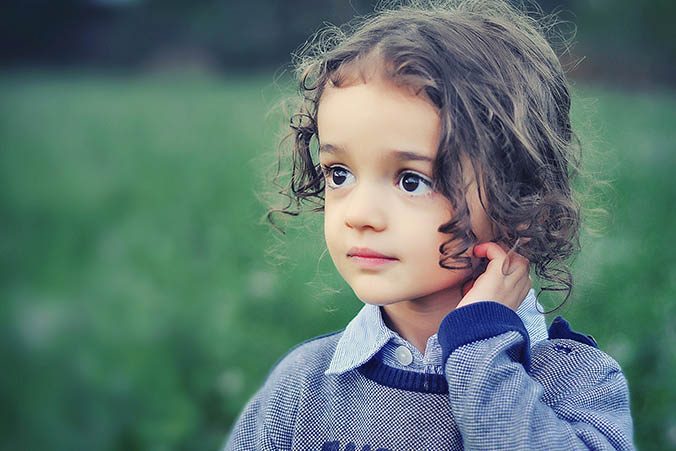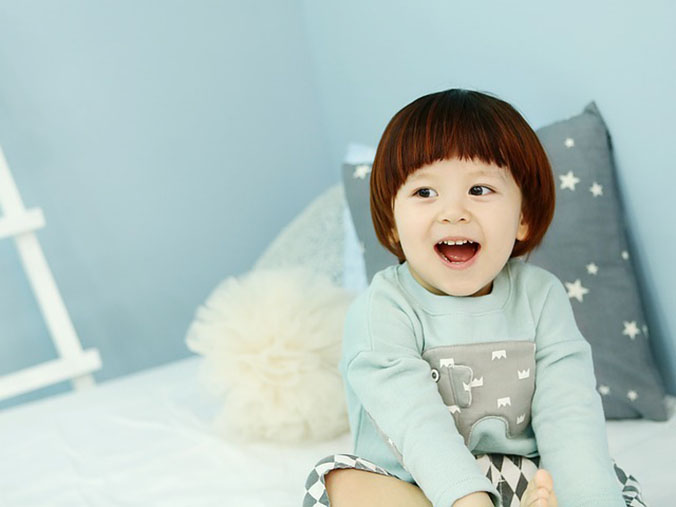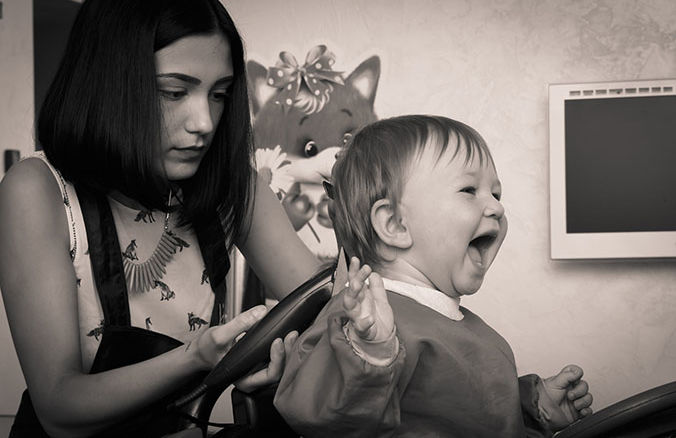Long hair, skinny hair, green hair, short hair, how many-many hairs do we self-care for? Truth is, hair of all kinds needs different attention to make the most out of it; if you tend to have frizzy hair then you may want something to calm the frizz or maybe you would like it to be even more defined curls on your head. So what exactly is the overall recommendation to care for your hair and how do you achieve the luscious locks that you are striving for in your child?
Typically, as a parent, you probably aren’t giving much thought into hairstyles or the looks of your kid’s hair aside from the basic haircut to not look so goofy or fit their cute face shape. There is one thing though, that all parents should keep in mind when it comes to teaching a child how to care for their own hair; that being hair health.
It seems that children who are raised to understand that hair has its own health system and do best with maintaining a daily routine to ensure their own hair stays in optimal health.
The environment that hair thrives in comes down to a few important aspects such as; brushing, nutrients and keeping a distance from other kids hair in school and what not. Yet, there are many more key points. So let’s take a look at 8 values we can teach our own children to create a healthy viewpoint for the coming years into teenhood to adulthood.

Brushing Every Day Keeps the Rats Away
Youngsters at often times don’t favor sitting down and getting under the hairbrush; if you have a child that loves to be pampered, kudos to you! The best thing to offer a child is starting them at a very young age with daily hair brushing habits. If you can sit down with your child once a day to comb through all of the rats your on the right track.
Once you have this down you can begin to research or set a schedule of when it works best for your child to sit through a good hairbrush. For instance, hair likes it best to not be brushed until it is all the way dry after a shower or bath. Waiting until your hair is dry to brush ensures minimal breakage and split ends. Once you set a routine to be sure to stick with it to keep locks silky and smooth.
Coconut Oil on Dry Hair works like Magic
As you may have already heard by now — coconut oil is a great moisturizer for the skin and it is an amazing moisturizer for hair alike. Before or after the bath, lather a bit of coconut oil on your child’s hair and scalp this allows for hair to stay moisturized and lessen itchiness and split ends. Kids have no problem doing this in my experience and love to lather their faces and scalp up with the delicious smelling oil.
Due to coconut oils antimicrobial and antibacterial properties, it will also assist to reduce any risk of fungus or cradle cap type issues on the skin. You can lather oil on after your hair has dried from a bath as well but it doesn’t work so well if you try and put it on wet hair — oil and water don’t mix well and act as a repellent more so.

Regular Haircuts keep Things Growing and Going
Your babies precious may be something that you couldn’t fathom cutting off. Especially during the first year or so; but babies and kids should have their hair trimmed about once every 12 weeks to keep things growing nicely.
A good haircut every once in a while is like a fresh slate for hair; it gives the ends room to breath and begins to grow faster and stronger. You will realize that when you trim your child’s hair they get a boost of confidence because their hair feels so fresh and sleek. You can give your child the option to choose a haircut too within reason. A good idea is to do this once at the start of each school year or a certain month to create a fun routine. Then multiple little trims every 12 weeks in between the annual cut.
Wash & Condition as Needed
Some children need to wash their hair daily and others every three days. This routine is usually set by parents; when followed by you begin creating a lifelong routine for your kids self-care habits. Of course, if your child has a day in the sand or summer heat that caused them to sweat a ton then you will want to teach them the importance of washing their hair after a dirty hair day.
The type of shampoo and conditioner that you use on your child’s hair is of course up to you; of course, it is always best to keep in mind that you will probably want to use an organic or at least natural type of shampoo. This ensures you don’t have a buildup of wax and chemicals on the strands of your kid’s hair which causes it to look greasy and dirtier and is flat out bad for their health. Shampoo bars or homemade shampoo from your local co-op are a great way to get the best type of shampoo in your routine. Then a bit of apple cider vinegar is a great conditioner for any kid.

Diet is Everything when it Comes to Healthy Hair
A child may not understand that the food they consume has everything to do with how their body re-creates cells to overall makeup their healthy thriving bodies. This includes the way that their hair grows, looks, and feels throughout their lifetime. If they eat junk foods that have little to zero nutrients it is likely that their hair will look greasy and not grow as efficiently as it could.
Teach your kid that eating healthy and foods that are rich in vitamins and minerals needed to promote a healthy lock like vitamin A, folic acid, biotin, and zinc. The best part is that you can get a multivitamin specifically for children’s hair growth to further this concept.
Herbs & Clay Detoxes
Hair is a picky little deal and it really needs a mix of herbs and vitamins to complement its texture and color. You can do a bit of research and have your kid do a hair soak in some nourishing herbs. This not only gives their hair more vitamins and minerals but it can be helpful in combating things like dandruff and head lice.
Little to be known is a form of clay called bentonite clay; it helps to do a clay detox on the hair to remove build up of toxins that clog the hair follicles diminishing their ability to breathe properly to grow.
What Type of Locks you Have Makes a Hairy Difference
Kids can have all different types of hair from curly to straight to frizzy. Each type of hair needs a different kind of aftercare. For instance a young child with super curly hair that rats easily may need a different type of comb or brush alongside products than a child with stick straight hair or a kid with very short hair.
Short hair won’t need any kind of brush mostly likely but you can use products like gels to teach your kid to style his hair. A young child with curly hair could benefit from detangler; teaching your little one to use a detangler could benefit him or her in the long run and well into adulthood by not forcing and breaking the hair during brushing but rather being gentle with it.

So How should a Kid Really Brush their Hair
Brushing hair may seem straightforward; though there are many different methods that people use all around to brush or comb their hair. The best way to brush long hair is to start from the bottom and work the way upward to the crown of the head.
Starting at the bottom of the hair allows for the possible tangles to fall out freely or be worked on as you move upward. It’s helpful to teach little kids how to start at the bottom or section their hair off when brushing that way they overcome little goals and don’t get overwhelmed by the many rats they encounter along the way.
When hair is wet or in the shower or bath it can be brushed while conditioning it. This is best if only done by a wide mouth comb to not pull any of the hair strands too hard and break it. Little kids with extra short hair can use a simple tiny toothed comb or head-scratcher to stimulate blood flow and renew the cells on the scalp to promote healthy circulation.
Teaching Your Little one to Hair Care is Overall Important
Kids need a lot of help and one way this stands out is in their hair care. It’s great to teach your young one how to care for their hair and establish a set routine when they are very young. Starting a hair care routine in the time of infancy will get your kid onto caring for their own hair sooner than later. Once you teach them the basics of the mentioned above they will have a better understanding of the anatomy of their own hair systems and how to keep themselves healthy and clean in this way.
At some point, your babies ‘new baby’ scent will begin to fade and starting with cradle cap ages you will want to implement a hair care routine into your child’s day. If you do not teach your kid the importance of self-hair care then it could result in unwanted dandruff or fungus growth on their heads. The thing is that it may be tedious at first to always pick up on caring for your child’s hair in the right way; but well worth the dedication and care.
AUTHOR’S BIO: DANIEL CHABERT
Snowboarder, drummer, and collaborator. Father of two amazing kids. He spends his time on managing sites such as Born Cute, That Sweet Gift, Nicer Shoes and Car Seat Experts.


